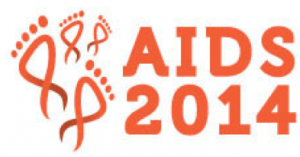Pill A, Pill B: simplified second-line treatment for low-income countries
1 August 2014. Related: Conference reports, Antiretrovirals, Treatment access, World AIDS 20 Melbourne 2014.
 Polly Clayden, HIV i-Base
Polly Clayden, HIV i-Base
A one pill, once-daily fixed dose combination (FDC) second-line regimen might be feasible for low-income countries according to a clinical development programme presented at AIDS2014.
Anton Pozniak from the St Stephens Centre at Chelsea and Westminster Hospital, London showed plans for a simplified second-line regimen at a scientific workshop entitled: Research to measure success of antiretroviral use for prevention and treatment at individual and community levels. [1] The workshop was the first public presentation of the proposed second-line development programme.
Currently, the preferred World Health Organisation (WHO) first-line regimen is a once-daily FDC of efavirenz plus tenofovir plus lamivudine or emtricitabine (EFV/TDF/3TC [or FTC]). Low cost, generic versions of this regimen are available and are simple to give in decentralised programmes by nurses and community health workers.
The WHO preferred regimens for second-line antiretroviral treatment (ART) are PI-based (ritonavir-boosted lopinavir [LPV/r] or atazanavir [ATV/r]) with two new NRTIs. These regimens have several shortcomings including overlapping NRTI resistance, comparatively high pill count, twice-daily dosing (LPV/r), NRTI toxicities and high cost compared to first-line treatment.
The new proposal for people who fail first-line treatment with “Pill A” (EFV/TDF/3TC) is to develop “Pill B” – a once-daily heat-stable FDC of dolutegravir (DTG) plus optimised darunavir/ritonavir (DRV/r). Market forecasts suggest that Pill B might be available at low cost: US$250 per patient per year.
Dr Pozniak explained that results from the original dose finding trials of DRV/r, as well as a more recent one with 600/100 mg, suggest that a dose reduction to DRV/r 400/100 mg might be feasible.
The dose ranging (phase 2B) study for the proposed development programme would compare three once daily regimens: TDF/FTC + DRV/r 400/100 mg vs DTG + DRV/r 800/100 mg vs DTG + DRV/r 400/100 mg. This phase would be conducted in treatment naïve participants over 48 weeks.
If 24-week phase 2B data justifies progression of the programme (no obvious safety or efficacy concerns), a 96-week phase 3 pivotal trial with 1050 NNRTI-experienced participants will follow.
Phase 3 – a non-inferiority study conducted in sites in Africa, South East Asia and Eastern Europe – would compare 2NRTI+PI/r (control arm) vs DTG + DRV/r 800/100 mg vs DTG + DRV/r 400/100 mg.
Comment
The success of this programme should make switching people who are on current first-line regimens with virologic failure to second-line considerably simpler and more accessible.
The one criticism is that this would lead to recommending DTG second-line when many experts believe it should be the preferred first-line option in the future. It is critical that work is funded to ensure that we have enough information to use DTG first-line in low-income settings but research into first- and second-line DTG-based regimens should not be mutually exclusive. A better second line option is needed for the 5% of nearly 13 million people on first-line (and more as scaling up continues) that need to switch. Dr Pozniak noted that if a DTG/TDF/3TC (or even DTG/TAF/3TC) becomes the future Pill A, Pill B might be DRV/r plus rilpivirine – which also needs to be investigated.
Research into optimising ART for low-income countries – usually discussed in small closed meetings -stepped out of the shadows at this conference including this presentation and results from a study with reduced dose AZT (see below). [2]
We also summarise work on treatment optimisation in the 2014 Pipeline Report. [3]
References:
- Pozniak A. How can we evaluate simple sequences of first and second-line treatment in low-income countries? 20th International AIDS Conference. Melbourne. 20-25 July 2014. Workshop presentation TUWS1105.
http://pag.aids2014.org/session.aspx?s=1967
http://pag.aids2014.org/PAGMaterial/PPT/1486_1326/melbourne_trials_pozniak_july14.pptx (Slides) - Rougemont M et al. The MiniZID study: a randomized controlled trial on safety of reduced dose (400 mg) of zidovudine compared with standard dose (600 mg) in HIV-infected patients starting antiretroviral therapy. 20th International AIDS Conference. Melbourne. 20-25 July 2014. Poster abstract LBPE16.
http://pag.aids2014.org/abstracts.aspx?aid=11206 - Clayden P. Fit for purpose: treatment optimisation. i-Base/TAG. 19 July 2014.
https://i-base.info/htb/26960

